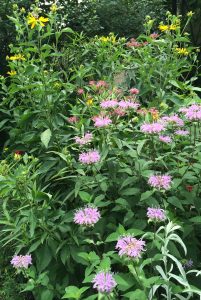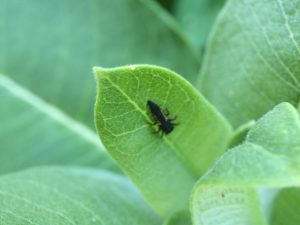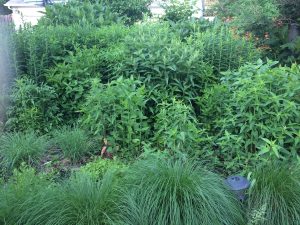Summer is almost here, and plants are up. You’ve been a good dooby and left some stems standing to provide habitat/nesting areas for cavity-nesting bees (such as Mason Bees and tiny Carpenter bees). Maybe you’re also worried about pulling weeds and not sure how best to handle the situation. Below are some quick and easy tips for tidying up in an environmentally beneficial way.
These tips are for a healthy, well-balanced, pesticide-free (organic or chemical) native plant garden. Here are the what’s and the why’s:

Trimming:
What to do:
Clippers are my favorite tool throughout the summer. If you want to tidy up your garden (I usually do for the front garden), you can trim the stems to the height of current foliage and lay the cut branches on the ground. You can keep the stems, and eventually they will be hidden by the foliage.
It’s ideal if you have places in your yard where you don’t trim the stems at all and rotate the sections where you trim year to year. The less disturbance (i.e. maintenance), the better. Another good reason to leave some dead stems standing is that birds and dragonflies prefer use dead stems for perching.
If you keep any tree saplings (such as elm and hackberry) around to support the many beneficial insects as well as beautiful butterflies and moths, you can keep those trimmed before they get too large and overwhelm your garden. Place anything you trimmed at the base of the tree.
You can also prune native asters too now before July 4th to give them enough time to set new flowers for the fall. Again, anything clipped should go near the plant.
Trimming an overly thick section plants or thin out an excessively dense stand too if you weren’t able to pull plants is another effective strategy; keep the stems sprinkled around at the bottom of the plants.
Why:
Keeping stems up and/or in the garden ensures that any beneficial insect (butterflies, bees, lacewings, etc) eggs/larvae are able to complete their life cycles. For butterfly caterpillars, once the leaves begin to wilt they will leave and travel to fresh food. It’s assumed a freshly hatched caterpillar would do the same too. Often, they eat their eggshell first and then go to the food plant.

With the clippings at the base of the tree/shrub/plant, the leaves will decompose fairly quickly while stems will decompose slowly, probably not to any noticeable degree until next year which will allow the insects (bees, butterflies, moths, etc) to complete their life cycles. The decaying stems and leaves provide food and shelter for soil organisms which benefits your plants. Fungi will do most of the heavy work consuming the lignin in the hard stems.
Invasive plants require proper disposal.
Weeding:
What to do:
Now is also a good time to keep up on weeds and thin out any volunteer seedlings too. You want to do this while the “weeds” are small and their root systems aren’t entangled in your desired plants. As you weed, pull up the weed seedling and leave it on the soil under or near another plant to disguise your tiny compost pile. Some people prefer to snip the seedling so that the soil remains undisturbed. If you are feeling extra-eco-friendly, keep a little patch of weeds somewhere inconspicuous and place the pulled weeds next to your contained patch (my little weed patches of lambsquarter, pellitory, chickweed, etc are in the backyard, usually hidden under or between taller plants). You can also keep those trimmed so that they don’t go to seed.
Why:
Letting the weeds decay naturally enriches your soil; the plant had to use up some of the soil’s nutrition, so it’s best to put all that nutrition back into the soil. Also, it could have insect eggs or caterpillars that can be hard to notice, by placing the “weed” next to a contained patch, you are letting it progress. Many weeds are also considered trap crops for pest insects (Lambsquarters for Spinach; Pigweed for many others). But in your habitat garden, many of those pests will be kept in check by beneficial insects (lacewings, ambush bugs, etc) and birds. I have pulled many weeds only to learn later that the plant was a host to some beautiful butterflies. Lesson learned: I keep everything as much as I can in the garden (exceptions are invasive species). I have seen birds munch on chickweed too.
Pretty simple and easy. More time to enjoy your garden and the life in it.
–Stephanie
Pam’s well-tended native plant garden, foliage is beautiful and interesting in itself.

